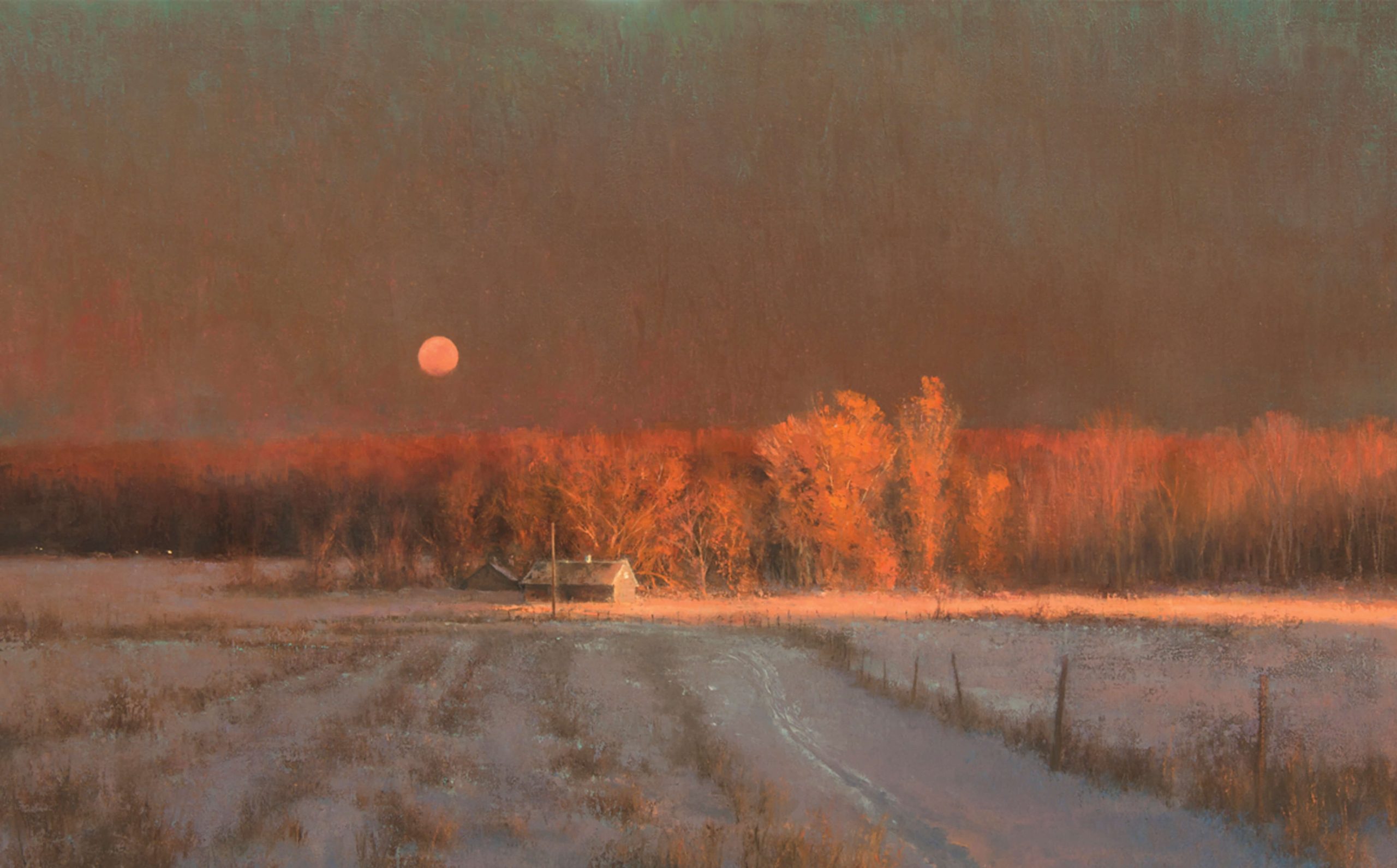
15 Mar Capturing the Elusive Light
Luminosity and radiance are two words that come to mind when describing D. Eleinne Basa’s paintings. The light in her work seems to live and breathe, to extend beyond the brushstrokes and reach a viewer’s mind and heart. The award-winning artist is modest and straightforward about her masterful, transporting depictions of light.
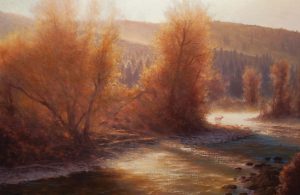
River Morning Light | Oil on Linen | 24 x 36 inches
“I think it’s just from the years of plein air painting,” Basa says. “[While painting outdoors], you immediately see what type of light you are dealing with. I love early morning or late afternoon light. It’s the light that gives you the mood of the scene, or what kind of painting you will do: a shady painting, a bright light and shadow piece, a tonal afternoon sunset, or a moonlight nocturne.”
Moonlight nocturnes are abundant in Basa’s body of work. Meadow Moonrise, Valley Moonrise, and Spring Moonrise are just a few of the paintings that highlight the gleaming mystique of the pearl in our sky. “The moon is one of my favorite things to look at,” she says. “I especially love the moonrise or low moons, the way they quietly appear and change the landscape instantly. I just love the moon’s beauty and how it transforms before your eyes as you watch it ascend into the sky.”
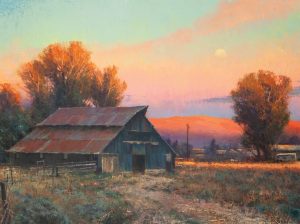
Evening Sky | Oil on Linen | 18 x 24 inches
Basa’s love for beauty is the well from which she draws seemingly endless inspiration. And it is the transmission of this beauty — rather than any desire to express a particular philosophy or message — that drives her to paint. “I feel something in front of a beautiful landscape. In trying to paint the beauty of that late afternoon light or early morning sunrise, I want the viewer to experience that morning or afternoon. I want to convey that beauty that I saw or imagined.”
Basa’s perceptions of beauty are indeed contagious, as James Corwin, owner of Corwin Galleries in Hamilton, Montana, has witnessed firsthand. “Customers are drawn to the magnificence of her work. People feel relaxed and a sense of awe. I can see their shoulders drop and tensions give way as they take in her paintings,” he says.
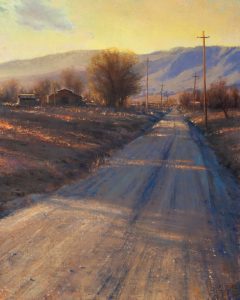
Afternoon Road Shadows | Oil on Linen | 20 x 15 inches
Visitors to Astoria Fine Art in Jackson, Wyoming, where Basa’s work is also on display, are similarly impacted. “There is something entrancing about her paintings that seem to immediately draw people,” says owner Greg Fulton.
“Eleinne’s work evokes a classical feel, reminiscent of the Luminist painters of the 1850s. Her techniques are masterful and [her] palette is exquisite,” says Corwin. But Fulton notes that even with its classical feel, Basa’s work touches a broad spectrum of art lovers. “I find that she is popular with collectors of both traditional and contemporary art,” he says.
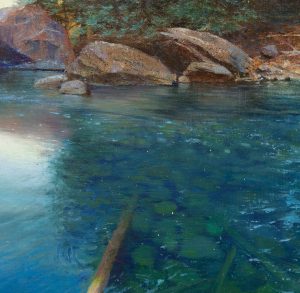
River Reflections | Oil on Linen | 10 x 10 inches
The fact that Basa’s work appeals to art lovers with both classical and contemporary sensibilities makes sense. She was trained classically from childhood — once she moved beyond the paint-by-numbers set given to her by an aunt, who noticed the young girl was always drawing. “My parents took me to study art every summer,” she recalls, “under a teacher who taught a lot of young kids the classical approach to learning how to draw, shading in charcoal, etcetera.”
Basa, who grew up in the Philippines, synthesized this classical training with her exposure to other art styles. “Although I was trained classically, the art that was being exhibited [in the Philippines] was stylistic, folksy, and modern. And when I immigrated to the United States, there was a very broad and diverse array of styles being promoted in shows and galleries.” At this stage, she developed her own skills and talent in the manner of many artists by copying what she saw, “the way I was taught when I was a child.”
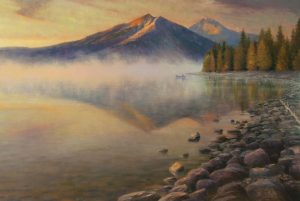
Lake Morning | Oil on Linen | 24 x 36 inches
In time, Basa found a local plein air group, and the practice of painting outside further developed her vision and style. “I joined them on weekly painting sessions,” she says, “and my love for plein air painting and landscape painting grew and grew.”
While painting the outdoor scenes that quietly unfolded before her, she also looked to the past, studying the works of Hudson River painters and early American Tonalists. She compiled an image library of inspiring art and looked at it daily. “At one point, every morning before I started to paint, I would scroll through my images on my monitor, studying and getting inspired,” Basa says.
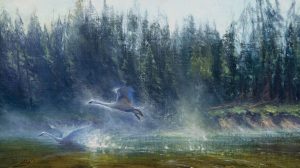
Touchdown | Oil on Linen | 8 x 16 inches
The effects of her study are evident in transportive, glowing, and richly hued compositions such as River Colors and Touchdown. The latter work shows a pair of swans landing on a pond, its disturbed surface breathtakingly mirroring the sunlight with which their white feathers are also haloed.
Along with Basa’s eye for beauty, medium and technique play significant roles in shaping her art’s uniquely expressive quality. “Oil painting enables me to be brave and experimental with my work. It’s forgiving and very versatile,” she says. “I’m also trying to study different ways to create texture. I love using the palette knife and also underpainting with thick paint, waiting for layers to dry, and layering with scumbling and glazing.”
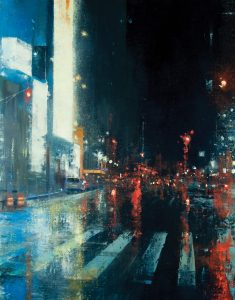
Times Square Reflections | Oil on Linen | 16 x 12 inches
These days, Basa mostly paints in her studio at home in New Jersey. “I still paint plein air, but not on a regular basis … mostly on my travels.” Many of her recent plein air paintings capture aspects of urban environments, including Florence, Paris, and New York City’s SoHo and Times Square. “When I’m traveling,” she explains, “I have a small window of time to paint. I think, ‘I can paint the trees and pastures anywhere, but these cityscapes are unique,’ so I paint them first.”
Whether she renders city lights reflected on a rain-soaked street, as in Times Square Reflections, or the buttery glow of an Aspen moonset, Basa achieves what so many artists strive for: she elicits feelings. “Her ability to capture the beauty of a scene while also evoking an emotional response,” says Fulton, “is what I believe sets her apart from other artists.”
“If there is any emotion viewers feel in my work,” Basa says with characteristic simplicity and humility, “then I think that is good.”






No Comments